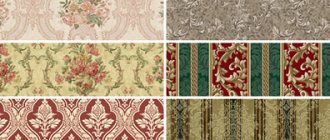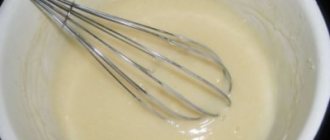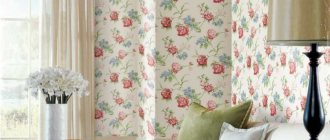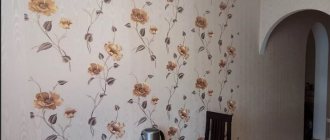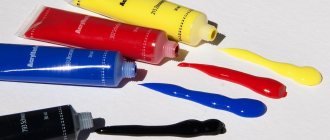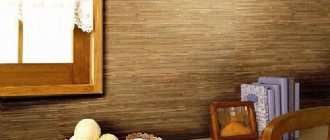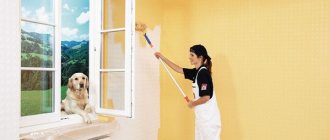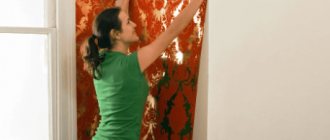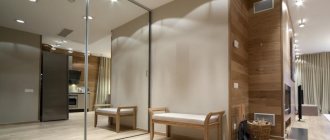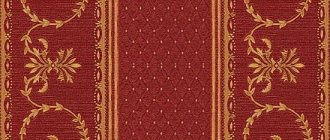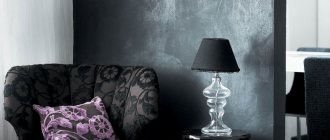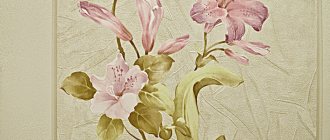Everyone wants to create a cozy and stylish interior in their home. After all, a home is a place where a person relaxes and spends time with family and friends. The interior of an apartment is the face of the owner, and the furnishings in the house speak not only of the owner’s wealth and status, but also of his taste.
The border must be glued to already dry wallpaper.
Wallpaper has been the most common and popular option for decorating walls in residential premises for many years. And this is not surprising, because the range of materials includes a large selection of colors and patterns. At the same time, wallpaper is an affordable material at a price where every consumer will find an affordable type of material for themselves.
Important advantages of wallpaper are environmental friendliness and ease of use. In order to bring the original design of the room to life, there is absolutely no need to glue wallpaper, which is very expensive. Even with cheap wallpaper you can emphasize your style if you use an original border.
How to glue a border to wallpaper: instructions from an expert
Few people in our country have not tried to glue wallpaper and edging to it with their own hands at least once in their life. Of course, for such an important task, you can, if you have the desire and opportunity, hire a team of craftsmen and a designer, and just return one day to a beautiful house that smells of fresh renovation. However, it will be even more interesting to feel “in your own skin” all the delights of choosing materials, the desired shade of wallpaper, and repair work.
Learning to glue a border
Almost everyone knows how to glue wallpaper with their own hands, but few know how to apply a border to wallpaper. Some people mistakenly think that decorating wallpaper with edging is simple and easy, but this is not entirely true. There are also many subtleties and nuances in this matter. The instructions below will help you study this issue in more detail, as well as a photo of the process of gluing the border and a video on this topic.
General points related to the border
There is currently a fairly wide selection of this material on the market. A smart decision would be to choose the edging directly when purchasing wallpaper. As a rule, a competent seller will be able to offer you several options for decorating your canvas.
Here it is important to decide in what style you want to decorate your home. You can select in different ways, in the first case you should focus on the color shade. For a calming atmosphere, use a tape of the same color as the wallpaper, but with a different shade
To add brightness and dynamism, you need to use opposite colors of the spectrum. The second method involves relying on a drawing. The design should be consistent with the ornament on the walls. It may differ in scale or color scheme, but it should still be similar.
Border with accent.
For what coatings is it used?
- If we talk about paper wallpaper, then this is for the most part an economical option; they are glued quickly and easily, but they do not last so long, they often lose their shine and fade. The most you can do is wipe off the dust with a dry cloth.
- Vinyl sheets are considered the most stable; they are not afraid of almost anything. They can be wiped with a damp sponge and even washed gently with gentle detergents. Vinyl is UV resistant and quite durable. You will get tired of them before they become unusable.
- Textile tapes are a specific product, their price is quite high and such finishing is suitable only for an interior made in a certain style. Here you can often find two-level wallpaper, to separate which a special border or frieze is used.
- There are also tapes with acrylic coating; they are quite durable and beautiful, but their price is lower than that of vinyl. Another advantage is that acrylic is a breathable coating.
- An interesting effect can be achieved by using synthetic colorless borders. They have a certain texture and are used in tandem with plain coatings for painting.
Children's theme.
Where can I glue the tape?
Wallpaper border tape can shade or separate. With low ceilings, it is better to put a narrow edging along the top and leave it at that. If you want to add some zest to the interior, then you should try to combine wallpaper of different colors, separating them with a border, but do not forget, the wider the tape, the lower the ceilings will appear, plus the tape is started either at the height of the window sill, or at 1/3 of the height of the wall . Otherwise, the ceiling will also drop significantly.
Separation of textile wallpaper.
As for the bottom edging, it is used extremely rarely and mostly to hide unevenly glued canvases.
The video in this article shows the general technique for working with wallpaper.
Materials and tools
You don’t need anything special to stick the border; all the accessories that helped glue rolls of paper to the walls will come in handy. So, to decorate the walls with borders you should have the following “at hand”:
- tape measure and scissors;
- a thick, soft pencil of a neutral color or colored chalk;
- building level of sufficient length;
- special glue that will ensure strong adhesion of the edging to surfaces; it is sold in small jars or tubes;
- a flat tassel, its width should be slightly narrower than the width of the edging;
- roller for rolling pasted edges;
- if you plan to glue the border under the ceiling, you will need a ladder;
- brush for applying adhesive.
Border in the bedroom
Decorative borders for wallpaper: what makes them special
Borders are most often glued to the upper segment of the wall. This does not mean that only this option is acceptable, but this can be called a typical case. Although, it would not be amiss to consider the option of having a border around the perimeter of the ceiling, or, which is also interesting, in the lower third of the wall.
Features of the location of the curb:
- At the top of the wall it plays the role of a decorative edging, which definitely makes the room more comfortable.
- Along the perimeter of the ceiling, the border serves as a separator and zoner.
- Edging a wall near the floor with a border is a way to hide unsuccessful wall hanging when you made a slight mistake with the height of the wallpaper.
The border can be the boundary between the panel and the main wall. In this case, it is located at a height of at least 80 cm from the floor level
But the vertical use of borders is not uncommon. For example, if you need to visually divide a wall into two zones, this option is often chosen in the nursery. The border borders doors, mirrors, etc., in short, what you want to highlight.
Article on the topic: Kitchen furniture set - how to choose and not regret it
Calculation of the required amount of edging
Calculating the required quantity is quite simple - for this you need to know the perimeter of the room, that is, measure the short and long walls, add the two numbers and multiply the indicators by two. The result will be the footage of the edging that needs to be purchased. If the plans include decorating windows and doors with edging, the openings also need to be measured, and the resulting amounts added to the perimeter of the room. When purchasing borders, it would be better to play it safe and buy two or three spare meters of tape.
Master Class
The whole process is carried out in six simple steps:
- First you need to draw a base line along the wall, using chalk or a pencil. It is advisable to make the lines almost invisible; you can apply them with strokes. If there is no level, the base line can be marked by measuring the same distance from the floor at the desired height. All resulting points are then connected by a pale straight line.
- Next, you need to determine the position of the edging. If it is near the ceiling, then it must be mounted as high as possible. Sometimes the border is attached at a height of 90-100 cm from the floor, in this way you can enliven the walls, differentiate between two types of wallpaper, visually make the room wider and slightly reduce its height.
- Rolls of edging should be rolled out along the walls, cut into meter-long pieces (this will make them easier to work with) and the adhesive applied to them with a special soft brush. Then the tapes should be folded in half or like an accordion, with the glued side inward - this way they will be thoroughly saturated with the composition and stick to the walls more firmly.
- Having climbed onto the stairs (if the edging is attached to the ceiling), the folded border should be taken in your left hand, straightened and applied to the wall, along the previously marked line. Next, the strip must be smoothed with a roller, towards the edges from the middle, while removing air bubbles and excess glue from under it. So, moving along the perimeter, from the corner, you need to attach all the strips of the border. If there is a pattern, it must be combined. In the corners, the strips are glued using the butt method.
- The corner joints of the edging (on window or door openings) should be formed in this way: overlap the strips over each other, leaving an allowance of 15 cm, then draw a line diagonally and cut the vertical strip of edging along it. Next, bend the line diagonally and bring it to the longitudinal strip.
- The pasted borders should be processed again with a roller, carefully smoothing the joints and pressing firmly on the tapes.
That's all, the process of working with wallpaper edging is completed. After the wallpaper and border are securely glued, it is important not to open the windows and vents for 24 hours so that they do not begin to peel off from the walls due to drafts. The result of walls decorated with edging can be seen in the photo.
Decorating a room with a stylish border is not difficult; it can be done with your own hands, quite quickly. Even an inexperienced craftsman, one who holds a roller and brush in his hands almost for the first time in his life, can apply a border to wallpaper. The main thing is to follow the instructions, use high-quality adhesive, and carefully study the photos and videos offered here.
What is this
Borders that decorate wallpaper are decorative strips that can be glued to the edges of wallpaper, have the same length and provide for combining patterns. Depending on the type, they vary in width, material of manufacture, design and release form. Decorative ribbons perform several functions:
- They help to connect different wall coverings, thereby creating a transition between them.
- They create a complete look for the walls, changing its perception for the better.
Using wallpaper borders, you can zone a room space, bringing simple organization to it and highlighting important interior design elements. Border edgings can visually adjust the dimensions of an apartment/house space. In addition to creating borders at the junction, borders are purchased in order to reduce errors in finishing and accentuate the ceiling. Wall decorative material can differ in the type of base, and in the assortment of stores it is presented in a variety of ways. At the request of customers, you can choose products from the same series to match the existing wallpaper. In addition to matching the color scheme, the borders must have the same pattern. The edging in the form of a border can be very different. Stripes can be figured or regular. They have one edge always straight, and the second can be carved/wavy, asymmetrical and symmetrical. This makes it possible to play around with the drawing. For example, the bottom edge can be cut in the shape of leaves or scallops of images that are on the border.
Color decorative solutions are completely limitless. This makes it possible to choose wall decorations as accurately as possible to match the color of the wallpaper or other interior decoration. In addition to plain borders without ornament, there are options on sale with prints for every taste and color. The themes of the images are very different - from floral and laconic motifs and geometry to magnificent stucco molding and images of cartoon characters. Border material for walls is suitable for use in different residential rooms. Depending on the design, it is suitable for the living room, hall, bay windows, kitchens, dining rooms, work rooms, playrooms and children's rooms. In addition, it can be used to decorate the hallway, thereby highlighting the entrance area, which will highlight the wall panels. This type of decor can even be used to decorate closed loggias and balconies. But the quality of the material is very different. Some types of wallpaper borders are too thin. Despite their degree of elasticity, they can tear when gluing, and therefore you should work with them as carefully as possible. Moreover, when gluing, they can lie unevenly, and sometimes even form folds.
Characteristic
A border for wallpaper can be called a universal finishing material; in addition, in stores it is called edging, frieze, edging. All this will allow you to easily change the design and add interesting notes. There is an opinion that such an update is a thing of the past. But it is wrong, because you need to know how to fit it into the overall repair. After all, the edging has a large assortment and unusual color solutions.
What are his external characteristics? The product is a strip of different widths. Usually sold in rolls. But making a choice is not as difficult as it seems. In addition, in stores there is already a prepared edging for various wallpapers, so you don’t even need to spend a lot of time selecting. It is not uncommon for the wallpaper to be already on the wall, but the frieze has not been selected. In this case, you should carefully consider the selection. Stores may have the following wallpaper borders:
- Paper. It's a basic look and easy to stick on and remove. If you do not fix it carefully to the wall, the materials will easily tear and get wet. This is one of the cheapest options, but the service life is minimal.
- Vinyl. This is a more reliable type. They do not fade when exposed to sunlight, they are durable, so they have a longer service life. Can be washed if necessary. Due to these characteristics, this wallpaper border is found in bathrooms and kitchens.
- Acrylic. No less durable option. They are often compared to vinyl, but at the same time the price indicator is lower.
- Textile. This frieze has its own characteristics - the presence of two layers. The first is paper as a base, after which a beautiful layer is applied here, which serves as decoration. Velor is often used, but there are a lot of disadvantages. Thus, the material does not withstand mechanical stress and moisture. Dust settles quickly and can be damaged by animals. It is difficult to care for this type of tape because wet cleaning is prohibited.
- Fiberglass curb. This is one of the most durable types. It is this finishing material that will serve for a long period of time without reacting to external stimuli. It is unique and suitable for any room, but the price is higher than all previous ones.
